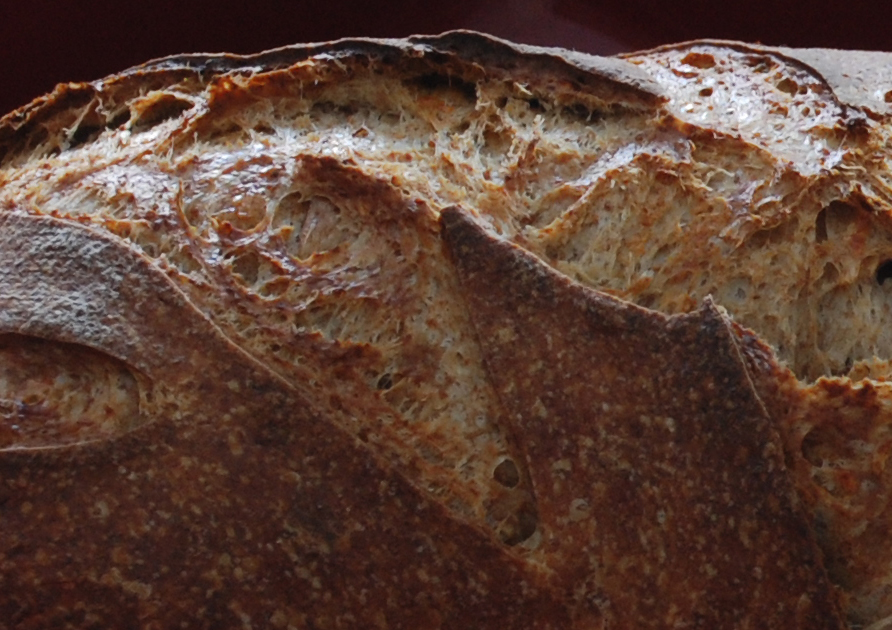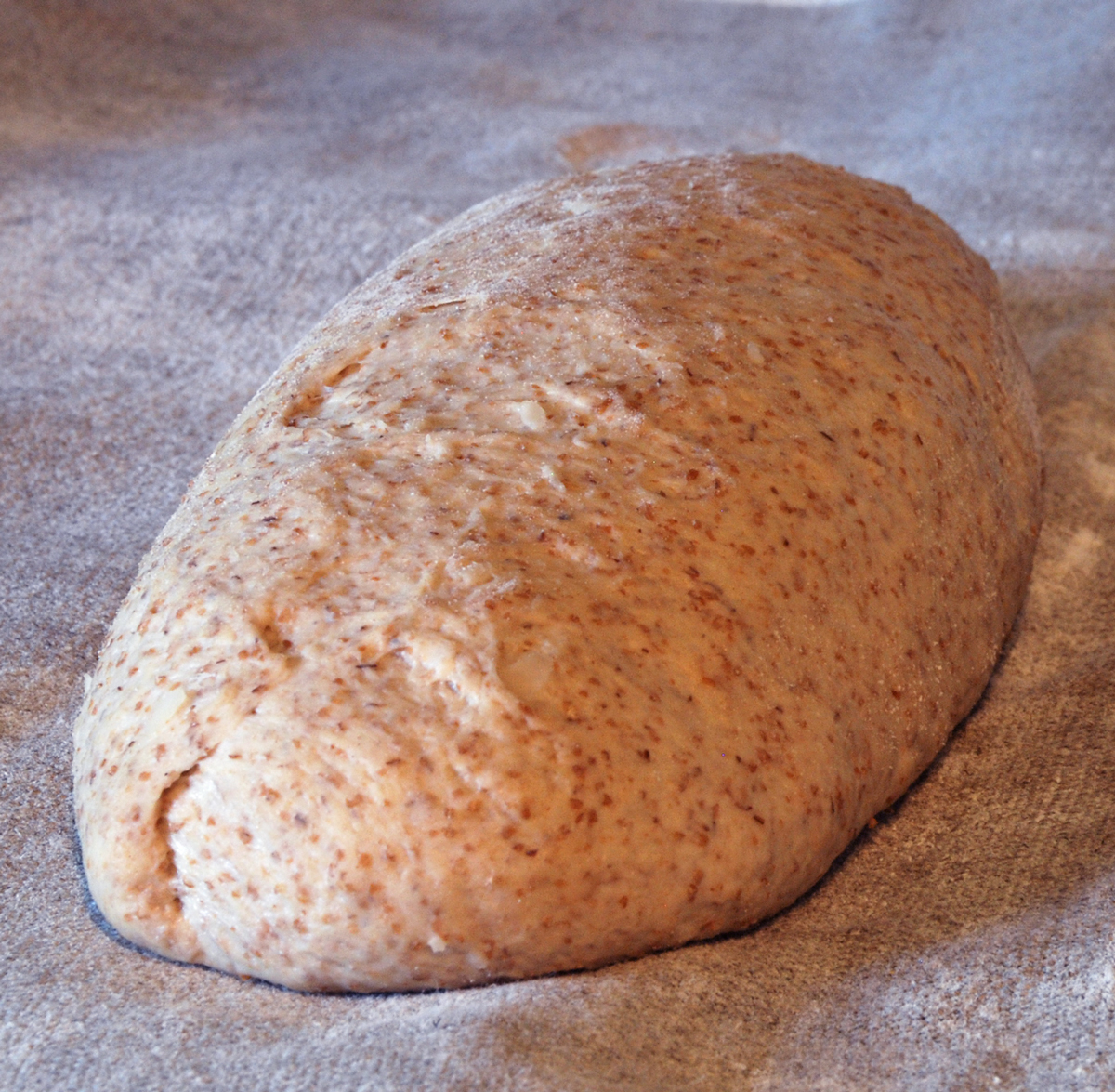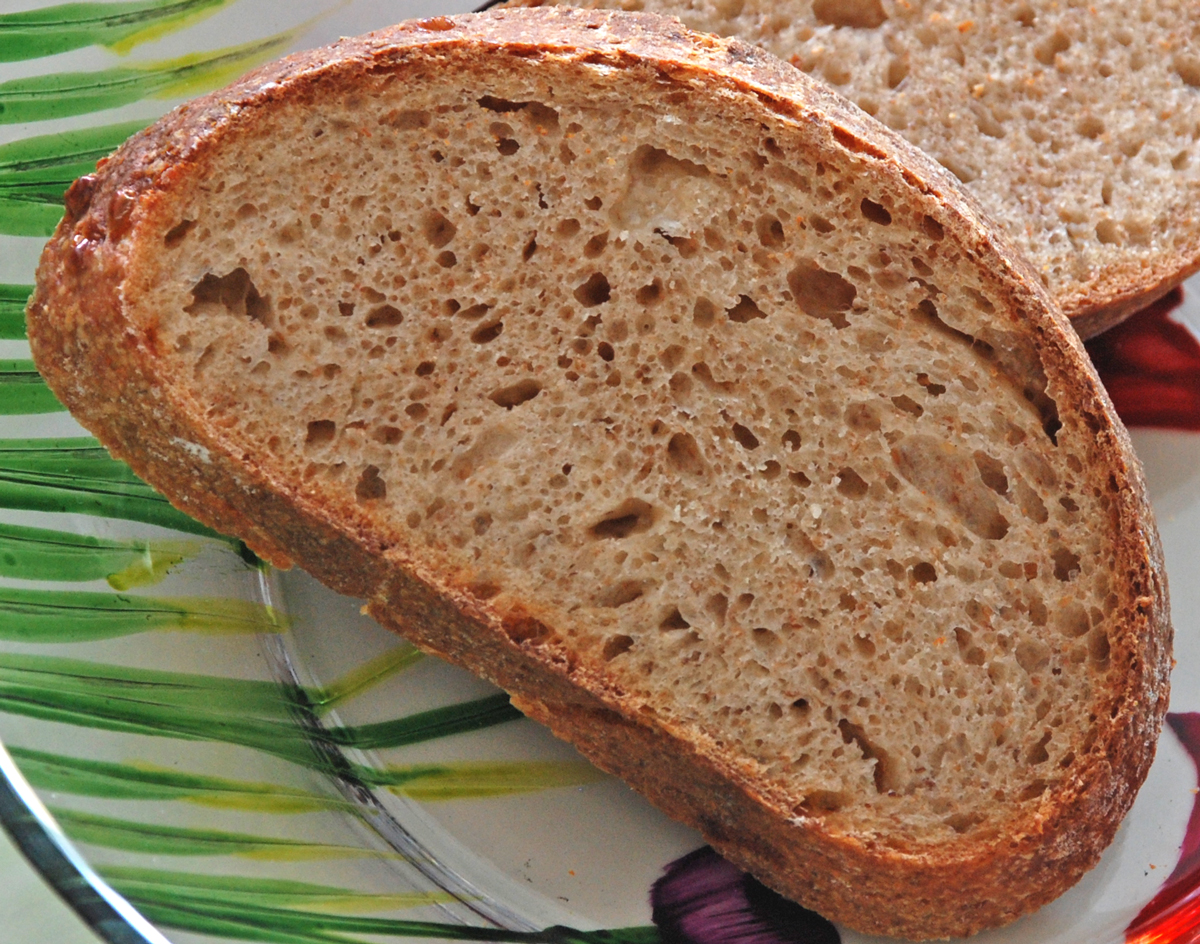 I just refreshed my Yeast Water starter earlier in the week after returning home from a long business trip. I have had great success mixing the Yeast Water starter with a traditional sourdough starter so I decided to follow a similar path. To make things interesting and because I happen to love durum breads I decided to make a 65% hydration YW starter using only durum flour and for the sourdough starter I converted some of my AP starter first to a 100% hydration starter using durum flour and sprouted whole wheat. I built both starters up in 3 stages over 2 days to make sure I had nice and lively starters. I didn't quite think through the amounts correctly so I ended up with a lot of extra starters. Not too worry as I'm making some YW Durum English Muffins tonight withe the extra starter. Feel free to adjust the amounts below if you don't want any left-over starter.
I just refreshed my Yeast Water starter earlier in the week after returning home from a long business trip. I have had great success mixing the Yeast Water starter with a traditional sourdough starter so I decided to follow a similar path. To make things interesting and because I happen to love durum breads I decided to make a 65% hydration YW starter using only durum flour and for the sourdough starter I converted some of my AP starter first to a 100% hydration starter using durum flour and sprouted whole wheat. I built both starters up in 3 stages over 2 days to make sure I had nice and lively starters. I didn't quite think through the amounts correctly so I ended up with a lot of extra starters. Not too worry as I'm making some YW Durum English Muffins tonight withe the extra starter. Feel free to adjust the amounts below if you don't want any left-over starter.
The end result was a nice open flavorful crumb with a crisp and chewy crust. You can taste the Parmesan cheese but it's a subtle flavor and does not overpower. This is a nice hearty bread to have with a nice Italian meal or a tasty sandwich.
Enjoy!
Procedure
Yeast Water Starter Build 1
60 grams Durum Flour (KAF) (note: this is not the same as Semolina Flour which is for pasta)
60 grams Yeast Water Starter
Mix the flour and Yeast Water in a bowl until thoroughly combined. Cover the bowl and let it sit at room temperature for around 6-10 hours. The starter should almost double when ready to proceed to build 2.
Build 2
Add ingredients below to starter from above and mix until incorporated. Cover with plastic wrap and let sit at room temperature for 6-10 hours.
100 grams Durum Flour
100 grams Yeast Water
Build 3
Add flour to starter from above and mix until incorporated. Cover with plastic wrap and let sit at room temperature for 4 hours or until bubbly and either use immediately or put in the refrigerator for the next day.
100 grams Durum Flour
10 grams Yeast Water
(Note: I made extra starter since I wanted to use this for another bake.)
Sourdough Starter Build 1
63 grams AP Starter
30 grams Durum Flour
33 grams Sprouted Whole Wheat Flour (You can use regular Whole Wheat)
75 grams Water
Mix the flour, starter and water in a bowl until thoroughly combined. Cover the bowl and let it sit at room temperature for around 6-8 hours. The starter should almost double when ready to proceed to build 2.
Sourdough Starter Build 2
60 grams Durum Flour
40 grams Sprouted Whole Wheat
100 grams Water
123 grams Sautéed Onions (sautéed in olive oil)
Mix the flour and water with the starter from build 1. Cover and let sit at room temperature for 6-8 hours until doubled and nice and bubbly.
Sourdough Starter Build 3
62 grams Durum Flour
40 grams Sprouted Whole Wheat
Add the flour to the starter from build 2 and let it rest covered for 6 hours until bubbly and nearly doubled.
Main Dough Ingredients
200 grams Yeast Water Durum Starter from Above
225 Sourdough Starter from Above
250 grams French Style Flour (KAF) (You can use AP Flour or Bread Flour to substitute)
150 grams Durum Flour (KAF)
100 grams Sprouted Whole Wheat Flour
70 grams Roasted Wheat Germ (this really adds a nice nutty flavor to the bread)
16 grams Seas Salt or Table Salt
51 grams Shaved or grated Parmesan Cheese
22 grams Olive Oil
425 grams Water (80-90 degrees F.)
Procedure
Build your Yeast Water levain and Sourdough starter the day before you are ready to bake.
The evening before you want to bake, mix the flours and the water. Mix on low-speed in your stand mixer or by hand for about 1 minute until the ingredients are combined. Let the dough autolyse for about 20 minutes to an hour.
Next add both levains and the oil along with the salt and mix for 3 minutes on low. After 3 minutes add the cheese and mix for about 1 minute until incorporated. The dough will come together and be slightly sticky. Place the dough in a slightly oiled bowl and do a couple of stretch and folds. Cover the bowl and let it rest for 10-15 minutes. Do another stretch and fold in the bowl and let it rest another 10-15 minutes. Do another stretch and fold and let the dough sit out in the covered bowl for another 1.5 hours. Place the dough in the refrigerator until ready to bake the next day.
When ready to bake take the dough out and leave it covered in your bowl for 1.5 to 2 hours. Next divide the dough into 2 loaves and either place in a banneton or from into batards and let them rest in floured couches for 1.5 - 2 hours.
About one hour before ready to bake, set your oven for 500 degrees F.and make sure you prepare it for steam. I have a baking stone on the top shelf and the bottom and use a heavy-duty rimmed baking pan that I pour 1 cup of boiling water into right as I put the loaves into the oven.
Score the loaves as desired.
When ready to bake place the loaves into your oven on your oven stone with steam and lower the temperature immediately to 450 degrees. It should take around 30 minutes to bake until the breads are golden brown and reached an internal temperature of 200 - 205 degrees F.
Let the loaves cool down for at least 2 hours or so before eating as desired.
- Isand66's Blog
- Log in or register to post comments





Hi Ian,
This loaf looks lovely! A question....I mix my sd starter with yw for the daily builds. I just substitute 1/2 of the total water with my YW. You went to a lot more trouble than I do to build and then use your 2 leavens and I am wondering if it makes any difference in the end by keeping them as separate leavens. Have you ever done a loaf by simply mixing YW with your sd? If you have, what differences do you detect?
I know this is a tough question to answer because there are so many variables and I know you usually bake using different ingredients in most of your loaves.
I ask because when I first began using the YW as a leaven I did keep 2 separate leavens but, over time, combined them because it was too much work to maintain 2 separate ones. I can't say that I have noticed any difference in texture or aroma in my breads since I made the switch. I can't comment on flavor because I can't eat what I bake. I do know that my leaven never gets that sour aroma it used to get if left too long between builds. Always has a nice subtle fruity aroma. If I want a sd without YW it is easy to change it back - takes just a couple of builds. Easy to switch to a rye sour or a spelt leaven too...Takes no more than a day.
End of interrogation :-)
As I said the loaf looks great. I just made a Risotto loaf with garlic primavera and Parmesan and I always love how the Parmesan makes a bread smell when baking - more so than with other cheeses.
Take Care,
Janet
Thanks Janet.
First, your Risotto loaf sounds amazing. Would love to see your recipe and bread if you get a chance.
I have never combined the YW with the SD starter like you have so I have no idea what the difference would be. I do want to try that one of these days. I have made bread with only the YW starter build and it comes out very nice with a soft and open crumb but no sour flavor. I find when combining both the SD and YW as two separate starters you still get the sour overtones with a soft crumb.
Regards
Ian
Hi Ian,
The formula for the loaf is HERE. One that Breadsong posted last summer.
According to Mr. D. by mixing my YW with my sd at 1/2 total amt. of liquid the sour can still be tasted. Just not as strong. I am sure mine still has sour notes to it because I use fresh grains and they don't need much to get sour :-) I also bulk ferment as you do overnight so the LABS do have time to do their thing.
If you try it let me know what you think. I went this route because my daughter prefers less sour. When working with my 100% sd starter things could get sour if my timing was off due to life circumstances calling me away....The YW allows me a 'grace' period :-) My daughter has always been my 'taster' but she has gone off to college so I have been having to use my nose since my son and husband can't tell any differences in anything I bake....to them it is all bread. Others I bake for haven't mentioned anything so I know I haven't gone too sour. Since you have baked with both and use whole grains I would love to have your input too....if you try this on one of your loaves. (I do my leaven builds in 2 stages. Each 3-4 hours apart. The flour is 100% to the seed and the liquid is kept at 70%)
No pressure...just when you feel like trying something new :-)
Take Care,
Janet
and your process is very clear. I love the burnished color of the crust. I had the same question as Janet but I see you have answered already. -Varda
Thanks Varda...I was very happy with the way this one came out. I think the fact that I use 2 baking stones, 1 on the top shelf and 1 on the 2nd lowest with a rimmed pan for steaming works well for me. I know some people use lava rocks, towels, etc. but I find just dumping 1 cup of hot water in my heavy duty baking pan works perfectly.
I do have to try Janet's method and see if there is any difference.
Regards,
Ian
bread inside and out. They have to taste great. The color semolina gives to bread is unique. Your bread looks perfectly baked.
You have to do a real combo starter by combining the builds of the YW and the SD. I do that all the time and I can't tell the difference if they are built separately. You still get the subtle SD tang and the bread keeps as well if it lasts long enough to compare.
I have a combo one going to do a panettone later this.week. I also have a new way to contain it :-) Glad your YW survived too.
Happy baking
Thanks DA...I will have to give it a go soon.
this is a tasty bread with a chewy crust.
re gards
Ian
Nice Ian! You didn't lose any skills while being away.
I am a sucker for cheesy breads so I am sure I would love this one. The crust looks amazing. You get great results with your steaming method too.
Enjoy this one!
John
Thanks John. I hope you give this a try one day. It's worth it. If you don't want to do the Yeast Water you can certainly just use SD only.
Regards,
Ian
was wondering if you could change grams and liters into tsp,Tbsps,and cups
thank you
chefscook
Thanks Chefcook.
There are numerous programs on the internet that will convert for you, but I urge you to buy a digital scale if possible. Once you start using one you will notice how much more consistent your baking will become. In the USA you can get one for less than $20.
Regards,
Ian